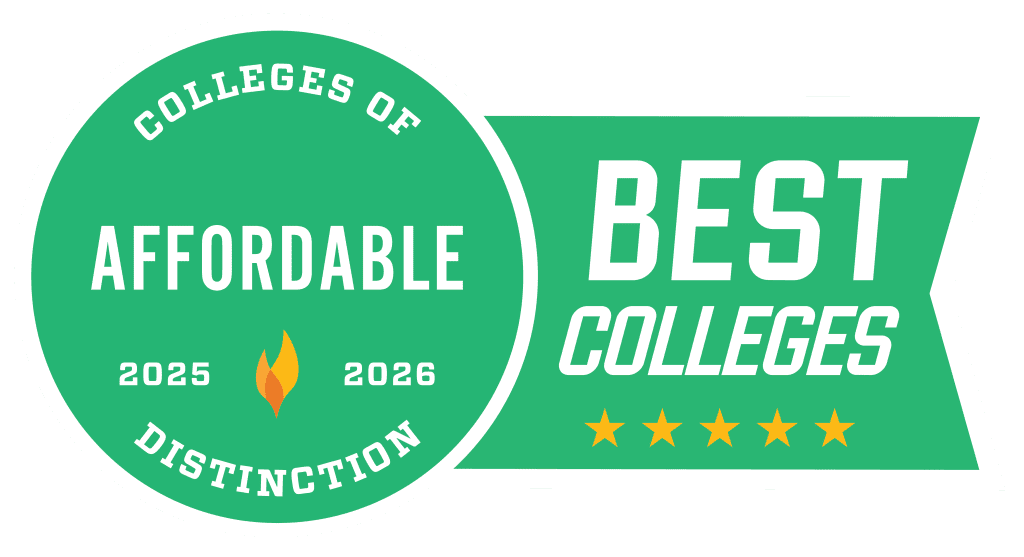Affordable Colleges: Unlock Your Future Without Breaking the Bank
By: Colleges of Distinction Staff
Jump to: Best Affordable Colleges | Methodology | Sortable Data Table
Choosing a college is a major financial decision, and finding an affordable college that offers a high-quality education is key to long-term financial success. While tuition costs continue to rise, many best value colleges provide strong academic programs, generous financial aid, and tuition assistance to help students graduate with minimal debt.
At Colleges of Distinction, we recognize that the true cost of college extends beyond tuition. By researching inexpensive colleges and leveraging available scholarships and financial aid, students can earn a degree that sets them up for success—without a lifetime of debt.
This guide will walk you through the most affordable colleges in the USA, financial aid opportunities, and smart financial planning strategies to make higher education accessible.
Understanding the True Cost of College
When researching affordable colleges, it’s essential to look beyond just tuition. The total cost of attendance (COA) includes:
✅ Tuition & Fees – The base cost of courses, which varies by institution.
✅ Room & Board – Housing and meal plans, which significantly impact expenses.
✅ Books & Supplies – Textbooks, lab fees, and materials.
✅ Personal Expenses & Transportation – Costs related to daily living and travel.
Many families focus on sticker price, but it’s more important to consider net price, which factors in financial aid, scholarships, and grants. Some of the best value colleges offer generous aid packages, making them comparable in cost to inexpensive colleges after aid is applied.
Use the net price calculator to estimate how much you’ll actually pay at different institutions.
🔗 Explore more about how financial aid can reduce college costs.
How to Identify Affordable Colleges
Not all affordable colleges sacrifice quality. Here’s what to look for:
1. Public Universities with Low Tuition and High ROI
Public institutions, especially in-state schools, often offer lower tuition rates while maintaining strong academic programs.
💡 Examples of Affordable Public Colleges:
2. Private Colleges with Generous Financial Aid
Many private institutions offset higher tuition costs with need-based and merit-based scholarships.
💡 Examples of Private Colleges with Strong Financial Aid:
3. Community Colleges & Transfer Pathways
Starting at a community college and transferring to a four-year university can save thousands of dollars.
🔗 Learn more about affordable college transfer pathways.
4. Work-Study & Tuition Reimbursement Opportunities
Some schools offer work-study programs, and some employers provide tuition reimbursement for employees pursuing degrees.
🔗 Discover how work-study programs can help pay for college.
Financial Aid and Scholarships: Making College More Affordable
1. Federal and State Aid Programs
Filling out the FAFSA is the first step to unlocking grants, loans, and work-study opportunities. Many states also offer their own scholarship programs for in-state students.
2. Merit-Based vs. Need-Based Scholarships
- Merit-Based Scholarships: Awarded for academic, athletic, or artistic achievements.
- Need-Based Scholarships: Awarded based on financial need.
🔗 Check out our ultimate guide to scholarships for tips on maximizing aid.
3. Tuition Reciprocity Programs
Students can save money by attending schools in participating states through tuition reciprocity agreements.
🔗 See if you qualify for regional tuition reciprocity programs.
4. External Scholarships and Grants
Search out mega list of scholarships or other scholarship articles help you find additional funding.
Smart Financial Planning for College
1. Budgeting Tips for College Expenses
- Track expenses using budgeting apps.
- Take advantage of student discounts on textbooks, software, and transportation.
- Live at home or with roommates to reduce housing costs.
2. Strategic Borrowing: Minimizing Student Loan Debt
- Prioritize subsidized federal loans, which don’t accrue interest while in school.
- Explore income-driven repayment plans for federal loans.
- Borrow only what you need.
🔗 Read our guide on reducing student loan debt.
3. The Benefits of Working Part-Time and Side Hustles
- Work-study programs provide on-campus jobs that align with your studies.
- Side hustles (freelancing, tutoring, online businesses) can generate extra income.
4. Alternative Education Paths
- Online degree programs offer flexibility and affordability.
- Dual enrollment allows high school students to earn college credits at a lower cost.
- Trade schools and vocational programs provide high-paying career options without a four-year degree.
Top Affordable Colleges in the USA
If you’re looking for the most affordable colleges with strong academics, consider institutions recognized for low tuition, high graduation rates, and strong financial aid programs.
Here are a few standout schools:
🏆 Affordable Public Colleges:
✅ San José State University (CA)
✅ University of North Carolina at Chapel Hill
🏆 Affordable Private Colleges:
✅ Saint Xavier University (IL) – low net price
✅ Dean College (MA) – Low Debt
💰See the full list of affordable colleges below
